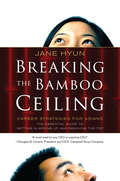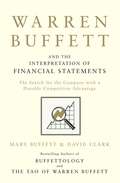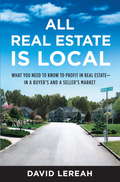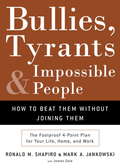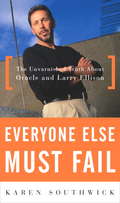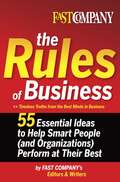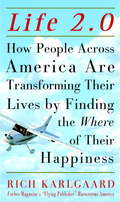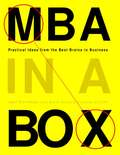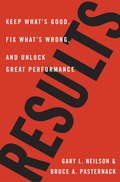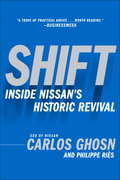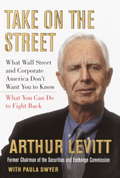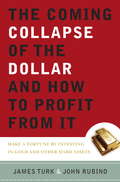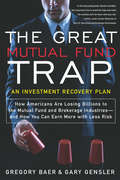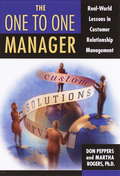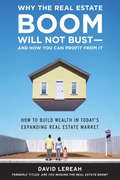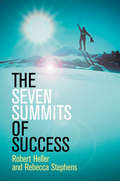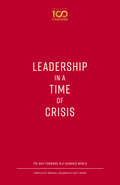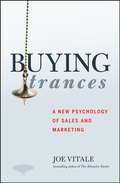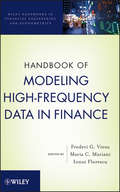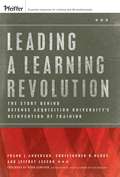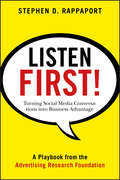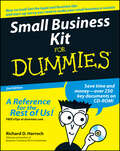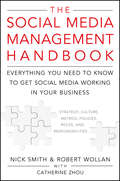- Table View
- List View
Breaking the Bamboo Ceiling
by Jane HyunYou're educated and ambitious. Sure, the hours are long and corporate politics are a bane, but you focus on getting the job done, confident that you will be rewarded in the long run. Yet, somehow, your hard work isn't paying off, and you watch from the sidelines as your colleagues get promoted. Those who make it to management positions in this intensely competitive corporate environment seem to understand an unwritten code for marketing and aligning themselves politically. Furthermore, your strong work ethic and raw intelligence were sufficient when you started at the firm, but now they're expecting you to be a rainmaker who can "bring in clients" and "exert influence" on others. The top of the career ladder seems beyond your reach. Perhaps you've hit the bamboo ceiling. For the last decade, Asian Americans have been the fastest growing population in the United States. Asians comprise the largest college graduate population in America, and are often referred to as the "Model Minority" - but they continue to lag in the American workplace. If qualified Asians are entering the workforce with the right credentials, why aren't they making it to the corner offices and corporate boardrooms? Career coach Jane Hyun explains that Asians have not been able to break the "bamboo ceiling" because many are unable to effectively manage the cultural influences shaping their individual characteristics and workplace behavior-factors that are often at odds with the competencies needed to succeed at work. Traditional Asian cultural values can conflict with dominant corporate culture on many levels, resulting in a costly gap that individuals and companies need to bridge. The subtle, unconscious behavioral differences exhibited by Asian employees are often misinterpreted by their non-Asian counterparts, resulting in lost career opportunities and untapped talent. Never before has this dichotomy been so thoroughly explored, and in this insightful book, Hyun uses case studies, interviews and anecdotes to identify the issues and provide strategies for Asian Americans to succeed in corporate America. Managers will learn how to support the Asian members of their teams to realize their full potential and to maintain their competitive edge in today's multicultural workplace.
Estate Planning 101: From Avoiding Probate and Assessing Assets to Establishing Directives and Understanding Taxes, Your Essential Primer to Estate Planning (Adams 101)
by Vicki Cook Amy BlacklockDiscover the ins and outs of planning your own or your loved one&’s last wishes with this easy-to-understand guide to estate planning.No one likes to talk about death, but being prepared for any unexpected tragedy can help your loved ones navigate your loss more easily in the long run. From creating your advanced medical directives to designating your beneficiaries, estate planning can ensure that your wishes are carried out when you are no longer around. With Estate Planning 101, you can get your affairs in order before any unfortunate incident occurs. This easy-to-understand guide comes with detailed information on what needs to be done to protect your estate. With information on creating a living will, minimizing estate taxes, choosing an executor, and more, you will be prepared for the future, no matter what it brings. Estate Planning 101 offers you step-by-step instructions and checklists to keep you organized for whatever life throws your way.
Warren Buffett and the Interpretation of Financial Statements
by Mary Buffett David ClarkWith an insider's view of the mind of the master, Mary Buffett and David Clark have written a simple guide for reading financial statements from Buffett's successful perspective. They clearly outline Warren Buffett's strategies in a way that will appeal to newcomers and seasoned Buffettologists alike. Inspired by the seminal work of Buffett's mentor, Benjamin Graham, this book presents Buffett's interpretation of financial statements with anecdotes and quotes from the master investor himself. Destined to become a classic in the world of investment books, Warren Buffett and the Interpretation of Financial Statements is the perfect companion volume to The New Buffettology and The Tao of Warren Buffett.
All Real Estate Is Local: What You Need to Know to Profit in Real Estate - in a Buyer's and a Seller's Market
by David LereahWhatever the national trends are with regard to real estate – whether they are booming or busting–what really matters is what the market conditions are in your region, town, or neighborhood. For as David Lereah points out, in the end, all real estate is local.What does that mean? Even during the real estate boom of 2001-2005, a great many cities and regions did not participate in the boom–they lagged behind, or even decreased in value. Similarly, when prices began to fall nationally, there were plenty of regions and locales where prices rose, and sales boomed. As Lereah makes clear, the most important factor in buying or selling a home isn&’t what is going on nationally–it is what is going on in your local market. Evaluating present and future trends and influences in your region or neighborhood is essential to creating long term wealth, whether you are in a buyer&’s or a seller&’s market. And David Lereah, as the Chief Economist for the National Association of Realtors, shows you how to determine the conditions in your neighborhood. Lereah reveals how to: Evaluate the DNA of homes in the town or county or region you are considering (every town has its own real estate DNA–the characteristics that make a region or city more or less desirable to live in).Determine whether property values in your targeted neighborhood are on the rise.Research future real estate influences and trends, from migration into or out of the region, to plans to attract or develop new businesses in the area. Understand the local factors that can affect your investment in the future.Countless books offer advice on how to buy and sell a home. But ALL REAL ESTATE IS LOCAL is the first book to explain how knowing the ins and outs of the local market you are targeting is essential to deciding when, where, and what to buy.
Bullies, Tyrants, and Impossible People
by Ronald M. Shapiro Mark A. JankowskiThe impossible people who make life’s journey so difficult are everywhere—at the office, in restaurants, on airplanes, living next door, members of your own family. They’re . . . • your “nothing is ever good enough” boss • the “no price is ever low enough” client • the next-door neighbor who redefines the meaning of paranoia • the maître d’ who looks through you as if you don’t exist • the father-in-law who you know is always thinking about how much better a life his Janey or Joey would have if only married to someone other than you Ron Shapiro and Mark Jankowski give you a simple and highly effective 4-point plan for dealing with all of them and more—N. I. C. E. Their system shows you how to neutralize your emotions so you don’t just react but act purposefully and wisely. It enables you to identify the type of bully, tyrant, or impossible person you’re facing—the situationally difficult (something has happened that turns an otherwise reasonable person into a temporary terror); the strategically difficult (she has empirical evidence that being difficult is a strategy that gets results); or simply difficult (being difficult is his 24/7 M. O. ). Then you’ll learn how to shape the outcome by controlling the encounter and, finally, how to get “unstuck” by exploring your options. Using colorful stories from all walks of life— “He called me the scum of the earth and it went downhill from there,” “First, lock all your vendors in a small room,” and “The boss from hell”—the authors bring their lessons to life, from business life to family life.
Everyone Else Must Fail: The Unvarnished Truth About Oracle and Larry Ellison
by Karen SouthwickKaren Southwick’s unauthorized account provides the full story of Larry Ellison’s brilliant, controversial career. Ellison’s drive and fierce ambition created Oracle out of the dust and built it into one of America’s great technology companies, but his unpredictable management style keeps it constantly on the edge of both success and disaster. The hostile bid for PeopleSoft is just the most recent example. With one clever strategic move, Larry Ellison threw much of the business software field into play.The saying “It’s not enough that I succeed, everyone else must fail” has been so often used by or associated with Ellison that most people think it originated with him. It’s actually attributed to Genghis Khan, but it’s a dead-on way to describe not only the way Ellison thinks about competitors but the way he runs Oracle. His weapons are not marauding hordes, but Oracle’s possession of database technology that is crucial for keeping mission-critical information flows working at thousands of organizations, corporations, nonprofits, and government agencies. Inside Oracle, Ellison has time and again systematically purged key operating, sales, and marketing people who got too powerful for his comfort. Most notable was Ray Lane, Oracle’s president for nine years, who was widely credited with bringing order out of the chaos that was Oracle in the early nineties and growing it into a ten billion dollar company. Ellison got rid of the one key person who was building confidence with Wall Street, business partners, and customers that Oracle was no longer flying by the seat of its pants and had its act together. Ellison’s mania for absolute control and his inability to coexist with the very lieutenants who bring much-needed stability to the company have brought Oracle to the brink of collapse before, and may well do it again. Ellison is a throwback to an earlier, much more freewheeling version of capitalism, the kind practiced by the nineteenth-century robber barons who ran their companies as private fiefdoms. Larry Ellison is one of the most intriguing and dominant leaders of a major twenty-first-century corporation, and Everyone Else Must Fail raises the question of whether Oracle’s products and the reliance placed in them by so many are too important to be subject to the whims of one man. While giving credit to Ellison’s brilliance and devotion, the book sounds a warning about an ingenious man’s tendency to be his own company’s worst enemy.
Fast Company The Rules of Business: 55 Essential Ideas to Help Smart People (and Organizations) Perform At Their Best
by Fast Company's Editors and WritersFrom The Rules of BusinessRule #1 The first rule of business is the same as the first rule of life: Adapt or die."What gets measured, gets done."--Peter DruckerRule #8 Nothing is more overrated than a new idea. Ideas by themselves are worthless. It's what you do with them that matters."Bet on the jockey, not on the horse." --Malcolm Forbes "Best practices usually aren't."--Christopher Locke, co-author, The Cluetrain ManifestoRule #49 If it is not right, don't do it; if it is not true, don't say it. "If you think you're too small to have an impact, try going to bed with a mosquito in the room."--Dame Anita Roddick, founder, The Body ShopIn THE RULES OF BUSINESS, Fast Company's renowned editor in chief, John Byrne and the writers and editors of Fast Company, distill the major ideas and principles of the world of business into fifty-five essential rules. These rules are elaborated on and enhanced by quotes and insights from over 200 business leaders, practitioners, and thinkers into what is sure to be an essential desk reference for managers, professionals, and executives-to-be.Published on the tenth anniversary of the magazine, FAST COMPANY'S THE RULES OF BUSINESS features the essential principles behind today's most important business topics, from customer service to innovation, from strategic thinking to leadership and management. The book introduces each category with a two-page commentary, and weaves two to four essential rules throughout every chapter. At the end of each chapter a boxed, bulleted "Fast Take" section gives readers specific takeaways they can use in their day-to-day work. The heart of each chapter, however, is the quotes and insights on the subject culled from the great minds in business, both living and historical--leaders and thinkers such as Machiavelli and Jack Welch, Adam Smith and his invisible hand and Tom Peters on marketing Me, Inc., Michael Porter on (what else?) strategy and A.G. Lafley, Jeff Bezos on the perils of hiring the wrong person and Bill Gates on the value of information technology, Anne Mulcahy and Warren Buffett, and many more.FAST COMPANY'S THE RULES OF BUSINESS is the ultimate desk reference.
Life 2.0
by Rich Karlgaard“A delightful, and surprisingly moving, tale” -- Michael Lewis, bestselling author ofMoneyball “Karlgaard flies in with a companion concept to David Brooks’sOn Paradise Drive” -- Tom Wolfe “While counterintuitive to those on the conventional fast-track,Life 2. 0offers great promise to those who are open to personal innovation” -- Clayton Christensen, Professor, Harvard Business School “This fascinating treatise will make you think deeply, and may just give you the impetus to uproot” -- Tom Peters “An original and exhilarating look at options many Americans don’t realize are now open to them. ” -- James Fallows, national correspondent,The Atlantic Monthly “Not only will it widen the horizons of your life, it could also renew your health and wealth. ” -- George Gilder Have You Found the Where of Your Happiness? One of the intriguing things about the United States is the idea of the second chance, that when you feel stuck there is always a frontier you can cross to reinvent yourself. InLife 2. 0, Rich Karlgaard used his own personal and professional midlife crises to look at the state of the American dream—the belief in continuous personal upward mobility—and where it stands in the twenty-first century. At the ripe old age of forty-five, Karlgaard fell in love with flying and mastered the art of lifting up and bringing down a “2,500-pound aluminum box kite”—a four-seat single-engine airplane. As the publisher of Forbes he felt that he was doing too much armchair theorizing and didn’t really understand how Americans were responding to the changes that had started taking place so swiftly over the past few years. So he put together his new flying skills and reportorial mission and flew around America to places like Green Bay, Wisconsin; Bozeman, Montana; Fargo, North Dakota; Des Moines, Iowa; and Lake Placid, New York, to gain some insight into how ordinary Americans are untangling the knotty problems of constant stress, crushing expense, and bewildering hassle that often characterize life in the nation’s urban centers. He discovered their simple solution: they moved. What Karlgaard found on the road are fascinating and inspiring stories about people— those with a nose for entrepreneurship, a faith in technology, and the willingness to take a chance—who are finding the new American dream in places as far from New York City and Silicon Valley as you can imagine. Some of those people include: • A burned-out insurance exec who fled his overworked East Coast life and settled in tranquil (yet dynamic) Des Moines • A tool broker who traded his brick-and-mortar business in sunny California for a life in the Pennsylvania hills, where he relaunched his business on the Internet • A road-warrior democracy specialist who conducts her worldly affairs from the low-key outpost of Bismarck, North Dakota • A self-made millionaire who paid for his financial success with his first marriage and who did things differently the second time around by moving to smaller cities and focusing on family as well as work Adroitly combining analysis of the economic and social trends challenging middle-class people with perceptive advice on how to escape the rat race of the coasts, Karlgaard explores the eye-opening possibilities of that huge tract of land often carelessly dubbed “flyover country. ” Filled with stories of personal reinvention and triumph, Life 2. 0 is the story of those who are living larger lives in smaller places. From the Hardcover edition.
MBA in a Box: Practical Ideas from the Best Brains in Business
by Joel Kurtzman Glenn Rifkind Victoria GriffithThe best minds in business—at your serviceMBA in a Box brings together some of the best brains in business who show how the core curriculum of an MBA program works in the real world. People like Michael Porter, Rosabeth Moss Kanter, Adrian J. Slywotzky, Warren Bennis, and Bill George give you a box full of ideas and tools that can boost your career and help you add value to your organization. For example: • Why finance is not just about manipulating numbers but of immense importance in sustaining growth, building widespread wealth, and creating jobs. • The profit zone and how to tell if a business is in one. • The skill of turning an idea or invention into a product that solves a problem for a market. • Merging the need of business to produce and grow with the environment so they are both sustained. • The latest thinking in marketing about branding, pricing, reversing a product’s life cycle, and turning what has become a commodity into a specialty.• And much more.
Results
by Gary L. Neilson Bruce A. PasternackEvery company has a personality. Does yours help or hinder your results? Does it make you fit for growth? Find out by taking the quiz that's helped 50,000 people better understand their organizations at OrgDNA.com and to learn more about Organizational DNA.Just as you can understand an individual's personality, so too can you understand a company's type--what makes it tick, what's good and bad about it. Results explains why some organizations bob and weave and roll with the punches to consistently deliver on commitments and produce great results, while others can't leave their corner of the ring without tripping on their own shoelaces. Gary Neilson and Bruce Pasternack help you identify which of the seven company types you work for--and how to keep what's good and fix what's wrong. You'll feel the shock of recognition ("That's me, that's my company") as you find out whether your organization is:* Passive-Aggressive ("everyone agrees, smiles, and nods, but nothing changes"): entrenched underground resistance makes getting anything done like trying to nail Jell-O to the wall* Fits-and-Starts ("let 1,000 flowers bloom"): filled with smart people pulling in different directions* Outgrown ("the good old days meet a brave new world"): reacts slowly to market developments, since it's too hard to run new ideas up the flagpole* Overmanaged ("we're from corporate and we're here to help"): more reporting than working, as managers check on their subordinates' work so they can in turn report to their bosses* Just-in-Time ("succeeding, but by the skin of our teeth"): can turn on a dime and create real breakthroughs but also tends to burn out its best and brightest* Military Precision ("flying in formation"): executes brilliant strategies but usually does not deal well with events not in the playbook* Resilient ("as good as it gets"): flexible, forward-looking, and fun; bounces back when it hits a bump in the road and never, ever rests on its laurelsFor anyone who's ever said, "Wow, that's a great idea, but it'll never happen here" or "Whew, we pulled it off again, but I'm tired of all this sprinting," Results provides robust, practical ideas for becoming and remaining a resilient business. Also available as an eBookFrom the Hardcover edition.
Shift
by Carlos Ghosn Philippe RiosIn Shift, Carlos Ghosn, the brilliant, audacious, and widely admired CEO of Nissan, recounts how he took the reins of the nearly bankrupt Japanese automotive company and achieved one of the most remarkable turnarounds in automotive—and corporate—history. When Carlos Ghosn (pronounced like “phone”) was named COO of Nissan in 1999, the company was running out of gas and careening toward bankruptcy. Eighteen short months later, Nissan was back in the black, and within several more years it had become the most profitable large automobile company in the world. In SHIFT, Ghosn describes how he went about accomplishing the seemingly impossible, transforming Nissan once again into a powerful global automotive manufacturer. The Brazilian-born, French-educated son of Lebanese parents, Ghosn first learned the management principles and practices that would shape his decisions at Nissan while rising through the ranks at Michelin and Renault. Upon his arrival at Nissan, Ghosn began his new position by embarking on a three-month intensive examination of every aspect of the business. By October 1999 he was ready to announce his strategy to turn the company around with the Nissan Revival Plan. In the plan, he consistently challenged the tradition-bound thinking and practices of Japanese business when they inhibited Nissan’s effectiveness. Ghosn closed plants, laid off workers, broke up long-standing supply networks, and sold off marginal assets to focus on the company’s core business. But slashing costs was just the first step in Nissan’s recovery. In fact, Ghosn introduced changes in every corner of the company, from manufacturing and engineering to marketing and sales. He updated Nissan’s car and truck lineup, took risks on dynamic new designs, and demanded improvements in quality—strategies that quickly burnished Nissan’s image in the marketplace, and re-established the company in the minds of consumers as a leader in innovation and engineering. Like the best-selling memoirs of Jack Welch, Lou Gerstner, and Larry Bossidy, SHIFT is a fascinating behind-the-scenes look at what it takes to transform and re-create a world-class company. Written by one of the world’s most successful and acclaimed CEOs, SHIFT is an invaluable guide for business readers everywhere.
Take on The Street
by Arthur LevittInTake on the Street, Arthur Levitt--Chairman of the Securities and Exchange Commission for eight years under President Clinton--provides the best kind of insider information: the kind that can help honest, small investors protect themselves from the deliberately confusing ways of Wall Street. At a time when investor confidence in Wall Street and corporate America is at an historic low, when many are seriously questioning whether or not they should continue to invest, Levitt offers the benefits of his own experience, both on Wall Street and as its chief regulator. His straight talk about the ways of stockbrokers (they are salesmen, plain and simple), corporate financial statements (the truth is often hidden), mutual fund managers (remember who they really work for), and other aspects of the business will help to arm everyone with the tools they need to protect—and enhance—their financial future.
The Coming Collapse of the Dollar and How to Profit From It
by James Turk John RubinoPeriodically, the global economy shifts gears in a fundamental way, turning conventional wisdom on its head and producing new categories of winners and losers among investors.
The Great Mutual Fund Trap
by Gregory Baer Gary GenslerConvinced that your star mutual fund manager will help you beat the market? Eager to hear the latest stock picking advice on CNBC? FORGET ABOUT IT!TheGreat Mutual Fund Trapshows that the average mutual fund consistently underperforms the market, and that strategies for pickingabove-averagefunds -- everything from past performance to expert rankings -- are useless. Picking individual stocks on the advice of brokers and analysts works no better. The only sure things are the fees and commissions you’ll pay. Fortunately, the news is not all bad. Investors willing to ignore the constant drumbeat of “trade frequently,” “trust the experts,” and “beat the market” now have the opportunity to do better. Using new investing products investors can earn higher returns with lower risks. Drawing on their years of Wall Street, Treasury and Federal Reserve experience, Gary Gensler and Gregory Baer offer a fresh and realistic look at how money is managed in America. From new indexing strategies to risk-managed stock selection,TheGreat Mutual Fund Trapoffers investors an escape from high costs and immunity from seductive marketing messages.
The One To One Manager
by Don Peppers Martha RogersLearn from the pioneers of Customer Relationship Management. InThe One to One Manager, visionary authors Don Peppers and Martha Rogers, Ph. D. , go behind the scenes to report on the challenges and solutions discovered by managers leading 1 to 1 efforts at organizations such as Xerox, General Electric, Oracle, First Union, Hewlett-Packard, USAA, Levi Strauss, and British Airways. Filled with in-depth interviews with executives on the front lines of the 1 to 1 revolution, and based on more than two dozen case histories from companies around the world,The One to One Managerexamines the actual day-to-day issues involved in setting up and running 1 to 1 initiatives. The One to One Managerintroduces readers to the groundbreakers, the pathfinders, and the explorers of a vast and rapidly expanding new universe of customer-focused business strategies. Among the fascinating pioneers profiled in this book, you will meet: General Robert McDermott, the visionary leader who transformed USAA from an insurance firm mired in paperwork into an IT-savvy financial institution dedicated to meeting customer needs at warp speed. Richard Vague, the CEO of First USA, champion of the "trusted agent" model for building lifelong customer relationships. Nina Smith, a Xerox marketing executive blazing a trail through a forest of competing sales and distribution channels. Royal Bank of Canada's Anne Lockie, who melds her knowledge of technology with a keen awareness of human nature to create 1 to 1 relationships with nine million customers. Bruce Varner, a Texas fire chief who trains his fire fighters to treat local citizens as valued customers. These early adopters, scouts, and risk takers offer managers and executives invaluable lessons in their efforts to map a new business universe in which organizations and enterprises organize around customer needs. It is a universe in which companies compete at extreme velocity, racing to devise strategies that will lock in customer loyalty, raise profits, and avoid the trap of commoditization. A virtual roadmap to the business world of the future,The One to One Manageris the book executives and managers the world over have been waiting for.
Why the Real Estate Boom Will Not Bust - And How You Can Profit from It
by David LereahWe are experiencing a historic wealth-building opportunity, says David Lereah, chief economist for the National Association of Realtors. As Lereah has predicted, the double-digit appreciation boom–far from a real estate “bubble”–is winding down to a healthy real estate expansion that will keep the long-term fundamentals for housing strong into the foreseeable future. To ensure that you don’t miss out, Lereah provides the tools, information, and analysis you need to become a savvy real estate investor.
The Seven Summits of Success
by Robert Heller Rebecca StephensWhen Rebecca Stephens first formed her goal of climbing Everest she was a young journalist with hardly any climbing experience, but with a strong vision and limitless determination to achieve her dream. It was a highly ambitious goal for such an inexperienced climber. Yet only four years on, she became the first British woman to climb the highest mountain in the world. That achievement led directly to her second great ambition: to be the first British woman to climb the Seven Summits, the tallest peak on each of the world's seven continents. In this inspiring book, Rebecca Stephens and management guru Robert Heller join forces to explore the mental skills, practical abilities and psychological powers that enabled her to achieve her dream. Whatever your personal ambition may be, the lessons of this unique book will lead you to identify, master and scale your own individual heights.
Leadership in a Time of Crisis: The Way Forward in a Changed World (100 Coaches)
by Marshall Goldsmith Scott OsmanThe founder of Marshall Goldsmith 100 Coaches presents insight on business and leadership in the age of COVID-19 from some of today&’s top consultants. This informative volume offers expert advice on navigating a business through today&’s global pandemic. Some of the world&’s most effective consultants give their perspectives on all areas of employee and customer growth and engagement. They also consider the ramifications of COVID-19 on people; the healthcare system; local, national and global economies; and on our businesses. In early March 2020, members of the nonprofit organization Marshall Goldsmith 100 Coaches began discussing the developments and repercussions of current events with each other as well as global leaders around the world. Thirty-seven contributors offer helpful and forward-thinking insights on how we can create more value in the companies we serve and better the lives of our coworkers and communities. Leadership in a Time of Crisis features essays by: Asheesh Advani, Jenny Blake, Peter Bregman, David Burkus, James M. Citrin, Erica Dhawan, Connie Dieken, Chester Elton, Robert Glazer, Sally Helgesen, Whitney Johnson, Tom Kolditz, Harry Kraemer, Martin Lindstrom, Rita McGrath, Sharon Melnick, Dave Meltzer, Richie Norton, Luara Gassner Otting, Liz Wiseman, And many more!
Buying Trances
by Joe VitalePraise for Buying Trances"The genius of Joe Vitale has never shone brighter. This thoroughly documented and easy-to-read book is the first of its kind. Vitale gives you the keys to their minds. All you have to do is turn the keys. They said 'yes' to you long before you said a word and they were begging to buy from you shortly after you uttered your first sentence. Buying Trances is an exciting ride to the edge of the mind. His finest work to date."-Kevin Hogan, author, The Psychology of Persuasion and Covert Hypnosis"This book maps marketing's final frontier-the customer's mind-and exposes the buying trance. Frankly, this may be the smartest marketing book ever written."-Dave Lakhani, coauthor, Persuasion: The Art of Getting What You Want"As with all of Vitale's books, there are magical secrets chucked out like a mad Vegas poker dealer on every page. Not only will you learn to put people into buying trances with this book, the act of reading it will put you in a trance and force you to master it."-Mark Joyner, #1 bestselling author, The Irresistible Offer: How to Sell Your Product or Service in 3 Seconds or Less"Vitale's expertise in hypnotic marketing combined with his extensive research challenges the reader on many different levels. He forces you to delve deeper into the benefits of creating a buying atmosphere and a trance-like desire on the part of your prospect. I found this an absolutelyfascinating book."-Joseph Sugarman, President, BluBlocker Corporation"Buying Trances is not your run-of-the-mill marketing book. It's an exceptionally well-written, well thought out, high-level work that gives the reader unique insights into how to capture a prospect's attention. Cutting-edge stuff that is a must for every serious marketer to absorb and implement."-Robert Ringer, author, To Be or Not to Be Intimidated?: That Is the Question"Vitale's understanding of how and why people think and act like they do is remarkable. Byunscrambling complex ideas and explaining them in simple language, he reveals how to fashion messages that will turn people into compulsive buyers of our products and services. Now we can take control and create the buying trance. It's a totally refreshing and very effective approach to hugely profitable sales and marketing!"-Winston Marsh, veteran Australian marketer
Handbook of modeling high-frequency data in finance
by Frederi G. Viens Maria C. Mariani Ionut FlorescuCUTTING-EDGE DEVELOPMENTS IN HIGH-FREQUENCY FINANCIAL ECONOMETRICS In recent years, the availability of high-frequency data and advances in computing have allowed financial practitioners to design systems that can handle and analyze this information. Handbook of Modeling High-Frequency Data in Finance addresses the many theoretical and practical questions raised by the nature and intrinsic properties of this data. A one-stop compilation of empirical and analytical research, this handbook explores data sampled with high-frequency finance in financial engineering, statistics, and the modern financial business arena. Every chapter uses real-world examples to present new, original, and relevant topics that relate to newly evolving discoveries in high-frequency finance, such as: Designing new methodology to discover elasticity and plasticity of price evolution Constructing microstructure simulation models Calculation of option prices in the presence of jumps and transaction costs Using boosting for financial analysis and trading The handbook motivates practitioners to apply high-frequency finance to real-world situations by including exclusive topics such as risk measurement and management, UHF data, microstructure, dynamic multi-period optimization, mortgage data models, hybrid Monte Carlo, retirement, trading systems and forecasting, pricing, and boosting. The diverse topics and viewpoints presented in each chapter ensure that readers are supplied with a wide treatment of practical methods. Handbook of Modeling High-Frequency Data in Finance is an essential reference for academics and practitioners in finance, business, and econometrics who work with high-frequency data in their everyday work. It also serves as a supplement for risk management and high-frequency finance courses at the upper-undergraduate and graduate levels.
How to Make Money Using Etsy
by Timothy AdamIn a world where most products are manufactured by machines, Etsy offers an online platform for makers of handmade products and crafts to market and sell their goods to a vast network of buyers who demand unique, genuine products. To date, the site has attracted over 400,000 sellers who collectively have sold over 30 million items, generating more than $180.6 million in revenue. The only resource of its kind, How to Make Money Using Etsy--written by Tim Adam who has successfully been selling his products all over the world through his Etsy shop since 2007--guides readers step-by-step through the many stages of selling online. How-to topics include:Establish your Etsy shopEffectively photograph your productsPost your products to optimize visibility and increase salesBrand your businessUse social media like blogs, Twitter, and Facebook to connect with buyers and grow your business
Leading a Learning Revolution
by Anderson Hardy Christopher R. Frank J. Jeffrey LeesonLeading a Learning Revolution tells the compelling story of a learning revolution that took place within the U. S. Department of Defense. Written by practitioners who actually walked the walk, this account of the creation of Defense Acquisition University (DAU) provides a clear blueprint that others can follow. It shares, in detail, the best practices they developed, so that the thousands of training organizations worldwide striving to create premier corporate universities can catapult forward. Offering an insiderÕs look at the process, the authors clearly explain how they transformed an outdated training provider into a world-class university. Step-by-step the book outlines the enduring principles that were pivotal to Defense Acquisition UniversityÕs success and describes the environment, early victories, current methods, and subsequent results. The authors discuss how to establish a mission and vision, develop a performance-based strategic planning process, and tackle change initiative. They also explain the development and implementation of web-enabled learning architecture and reveal how to effectively measure and evaluate performance. In addition, the authors present strategies for assuring continual improvement and organizational growth. With this book, any organization can tap into DAUÕs best practices and winning strategies for improving corporate learning.
Listen First!
by Stephen D. Rappaport"This superb book synthesizes the industry's best thinking on the massive upside of listening. Listen First! is an invaluable resource for marketing executives and will help organizations create real competitive advantage."--Dave Hudson, CEO, NM Incite, a joint venture of McKinsey and Nielsen"Listening is a business imperative . . . especially in a world of empowered consumers. Brands are getting built and nurtured in a very different way. This book is a must read for anyone who wants to succeed in this new world order."--Stan Sthanunathan, Vice President, Marketing Strategy & Insights, Coca-Cola"One by one, the best marketing companies are putting 'listening to consumers' on their strategic agenda. Following each announcement, we hear . . . silence, as staff groups try to grapple with the new directive. Listen First! is a timely, unhyped, and pragmatic field guide for those exploring the world of listening."--Ted McConnell, EVP Digital, Advertising Research Foundation; former head of Digital Marketing Innovation, Procter & Gamble"How many of you have an effective listening strategy? To help guide you in the listening maze, identify new business opportunities, and select the right partners for the development and implementation of an effective listening strategy, this book is a must and an enjoyable read!"--Prof. Yoram (Jerry) Wind, The Lauder Professor, The Wharton School"We started J&D's with a single idea - to make everything taste like bacon. All we needed now were customers. So we decided to go where the conversations were, and we've been listening ever since. We use social media to connect with our customers, promote our advancements in bacon-o-vation, and ask for their feedback on new product development. If you're an entrepreneur or run a small business, this book will give you lots of examples and terrific and practical ideas for creatively listening to your customers and growing it."--Justin Esch, cofounder, J&D's Foods
Small Business Kit For Dummies
by Richard D. HarrochMillions of Americans own their own businesses, and millions more dream of doing the same. But starting your own business is a pretty complicated matter, especially with all the legal issues and paperwork. This updated edition of the top-selling small business resource is chock-full of information, resources, and helpful hints on making the transition from a great idea to a great business. If you’ve got a great idea for your own business, you need the kind of straightforward advice you’ll find here — the kind of advice you’d normally only get from business schools and MBA courses. Small Business Kit For Dummies, Second Edition covers all the basics on: Recent tax law changes Balancing your finances Hiring and keeping employees Effective management strategies Accounting fundamentals In addition to the basics of business, you’ll also find top-class advice on more advanced business basics, like business plans, the ins and outs of contracts, and using the Internet to expand your business. For entrepreneurs large and small, this comprehensive resource offers authoritative guidance on all your biggest business concerns, and offers unbeatable advice on such topics as: Choosing your business structure — from LLCs to S corps How to develop and write a standard business proposal Going public, issuing stock, and keeping a stock ledger Raising capital and understanding securities laws Bookkeeping standard practices Tax basics for small businesses Handling the paperwork for new hires Designing employee compensation plans Working with independent contractors and consultants Patent and copyright protections Dealing with the Press In addition, the book includes a CD-ROM full of helpful resources — forms, contracts, and even sample versions of the most popular software for small businesses. With Small Business Kit For Dummies you’ll find all the tools you need to get your small business up and running — and keep it running for years and years to come.
The Social Media Management Handbook
by Nick Smith Robert Wollan Catherine ZhouHow do organizations manage social media effectively?Every organization wants to implement social media, but it is difficult to create processes and mange employees to make this happen. Most social media books focus on strategies for communicating with customers, but they fail to address the internal process that takes place within a business before those strategies can be implemented. This book is geared toward helping you manage every step of the process required to use social media for business.The Social Media Management Handbook provides a complete toolbox for defining and practicing a coherent social media strategy. It is a comprehensive resource for bringing together such disparate areas as IT, customer service, sales, communications, and more to meet social media goals. Wollan and Smith and their Accenture team explain policies, procedures, roles and responsibilities, metrics, strategies, incentives, and legal issues that may arise. You will learn how to:Empower employees and teams to utilize social media effectively throughout the organizationMeasure the ROI of social media investments and ensure appropriate business value is achieved over timeMake smarter decisions, make them more quickly, and make them stickGet the most out of your social media investment and fully leverage its benefits at your company with The Social Media Management Handbook.
